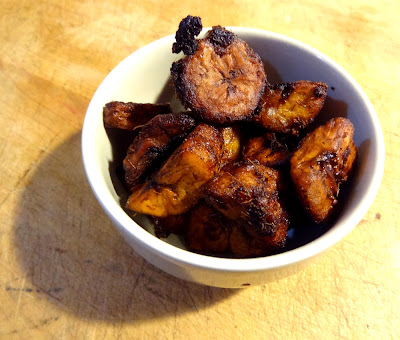When it comes to vegetarian food in Ghana and West Africa, I'm your girl. I have spent about 4 years (cumulatively) in Ghana in the past 10 years. I was a Peace Corps Volunteer there for 2 1/2 years, and while there I forged lasting relationships with many people. After I finished my service, I sort of stayed on in Ghana...and haven't really completely left yet. We have hosted & chaperoned 4 groups of teenagers in Ghana, to do development projects as well as to learn about the culture and see the sights.
 |
| palm nut soup...village style |
But I watched, and learned, and once I had my own kitchen, friends, and a grasp on the language, a whole new world of food opened up to me. There are quite a few delicious offerings in Ghana that a vegetarian can enjoy, especially if you are open to eating street food and snacks. And there are tons of dishes that you can make at home, sans fish or meat while still maintaining the integrity of the recipe. Some of my best memories involve listening to music, drinking local booze and cooking with my sisters in the village...learning from the best. I would like to begin sharing my some of these recipes with you, so you can have a taste of Ghana at home.
 |
| good times... |
I absolutely love this food, and I'm not the only one. Check out the kelewele facebook page, with over 30,000 members!
It consists of very ripe plantains, ginger, cloves, hot pepper and salt, fried in oil until dark and chewy. The plantains must be very ripe for this to be delicious, as it is the sweetness that sets off the spiciness. There are other recipes calling for unripe plantains in the Ghanaian repertoire but for this one they should be dark brown and a little bit soft. Here in the States, you can find plantains at Latino markets (sometimes called macho bananas) or at Asian markets. If they are not yet ripe, they will ripen on your counter with time. I like to add garlic as well, although I am not sure that all of the kelewele vendors of Ghana would approve...
In Ghana, one makes a paste or puree by using a locally made, clay mortar and wooden pestle (see fancy version below). The one I have here is more decorative than functional so I used an electric coffee grinder to pulverize the peppers, ginger, salt, garlic and cloves, and it worked like a charm.
 |
 |
| Plantains should be very ripe! |
Kelewele
- 4 very ripe plantains
- 2 habanero peppers (or 1/2 teaspoon cayenne pepper powder)
- 2 inches of fresh ginger, peeled and chopped roughly
- 2 teaspoons salt
- 1/2 teaspoon cloves
- 4 cloves garlic, peeled (optional)
Peel and then slice the plantains into medallions or chunks.
- Oil for frying (red palm oil if you can find it, otherwise vegetable oil is fine) I used rice bran oil.
Pour about 1 inch of oil into a skillet or pan over medium to high heat and allow to get very hot.
Grind the peppers, ginger, salt, cloves and garlic together into a paste, either with a mortar and pestle or in a coffee grinder. In a bowl, toss this with the sliced plantains until all are coated. When the oil is hot, carefully drop some of the coated plantain slices into the oil and fry, stirring occasionally until golden brown. Using a slotted spoon, remove them and drain on a paper towel for a couple of minutes. Repeat until all the plantains are cooked. This dish is best served hot.
One thing I have noticed when I make this in the States is that the plantains I find here are not as inherently sweet. In order to compensate, I heat a quarter cup of honey and toss the fried and drained plantains with it. Only then, does my Stateside kelewele taste properly sweet, salty, spicy...and perfect.




Hi Kirstin, love the blog! I make kelewele using garam masala and always crush some plain groundnuts over it. Oh wow now I'm hungry....
ReplyDelete~ Alisa (who remembers you fondly from Ghana circa 2005-2006!)